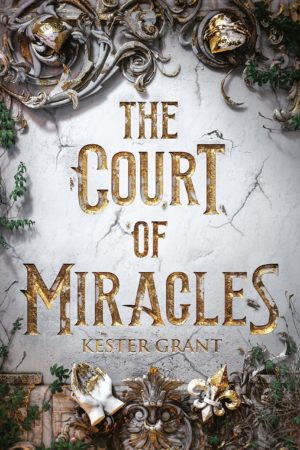The Court of Miracles by Kester Grant is set in an alt-history post-revolution France and inspired by the likes of Les Miserables and The Jungle Book. Its historical influences are very present as well, for example, The Court of Miracles (Cours des Miracles) being the name for one of the largest 17th-century, early 18th-century slum districts in France.

The heaviest literary influence on The Court of Miracles is very evidently Les Mis. The majority of the characters (it seems, based on what I later read) and their major character traits remain very similar to the original work, though they’ve been given nicknames (Cosette = Ettie, Eponine = Nina). As I hadn’t known anything about Les Mis before reading, I can’t say if knowing the background would’ve changed my experience reading The Court of Miracles. What I can say is, I enjoyed learning about the “original” characters once I’d read the re-telling as it gave me some more clarity on their origins. All that being said, the choice is yours! Do with that what you will.
Eponine, nicknamed Nina, is the protagonist of the novel and we love her. Nina’s character development from a scared kid to a scheming, morally questionable thief is very well done, but what I love most is her constant, fierce protectiveness for her sister and Ettie. Her relationship with Ettie, who is an absolute sweetheart, is lovely on its own, and as a way to draw out more of the soft side of her character. She acts for her sisters alone (for the most part) and reminds me of Katniss in a way, with how she prioritizes the people in her life over the larger picture. I love this about her character because it’s real. Nina is a regular (if extremely skilled and driven) girl in a world that forces her to make difficult choices to protect the people she loves. She isn’t looking for power or love or a new world order, she’s just trying to stay alive and keep her sisters safe.
If one was to call her a Mary Sue, I can’t say I’d disagree. For example, at the beginning of the book, as a child, she performs a miraculous heist. If we’d gotten more information about her training beforehand, this wouldn’t be as unbelievable, but unfortunately, we don’t. Her three love interests also add to this “problem,” though I was more annoyed by their lack of depth than their number. This was mostly with regard to Montparnasse and is due to the time skips, which get in the way of understanding important characters. I really hope to get to know them all more in the next two novels. Nonetheless, I can definitely see Nina’s wit and calculating and serious nature as appealing, so unlike in many novels, I completely understand their interest. Hell, I fell half in love with her. A (possibly) great note is that romance is extremely understated in this novel which is unique in popular YA fantasy these days. This allows the events and tensions of the plot as well as minor characters (and their relationships to Nina and the other major characters) to shine through.
As mentioned before, because of the time skips that occur, (which are necessary, since the book starts out with Nina as a child and ends in her teens), we don’t get a full picture of her relationships with other characters, but they are built through implication, in the same way as a life-long friendship might be at the start of a novel. This can be a little frustrating, but it’s a difficult spot to write one’s way out of.
The plot of The Court of Miracles isn’t itself complex, but the various “heists” that are orchestrated throughout it are, making the novel as a whole much more interesting. It’s largely driven by Nina wanting to protect Ettie, and is slowly paced, which can be frustrating for the reader, but also allows for a deeper exploration into the systems that govern the Court of Miracles, that being a group of lords and ladies who set rules for France’s criminal underbelly.
The way Nina navigates the three levels of society, though some of the encounters are largely accidental, allow for depth in worldbuilding that adds to the theme of moral grayness, which perpetuates itself throughout the novel. We get to see and evaluate the actions of the criminal underworld, the normal citizens, and the nobility, as well as their interactions with and perceptions of each other. The worldbuilding in this first book consisted mostly of historical background and politics, so I’d be interested to see if the “fantasy” aspect of the series comes into play more heavily in the next two books.
The Court of Miracles is a vivid, dark historical re-telling about characters who walk the line between good and evil, and the first YA fantasy I’ve read in a while in which the storyline of the obligatory revolution wasn’t completely predictable. Its characters are well-drawn and likable (even in their unlikability), and I can’t wait to get to know them more in book two.
Advertisement
Advertisement